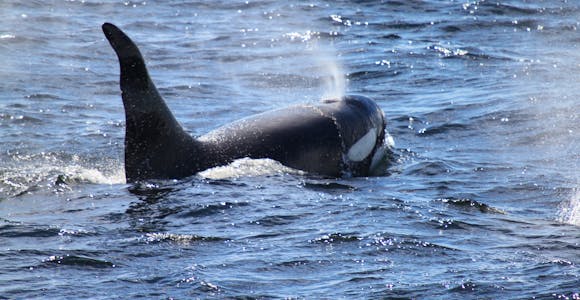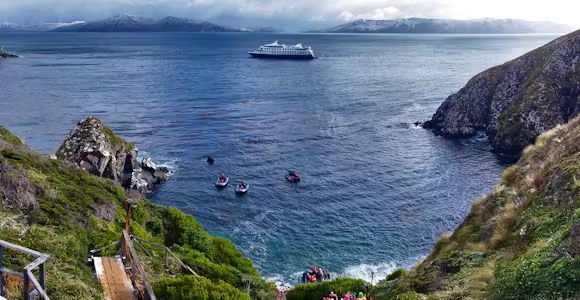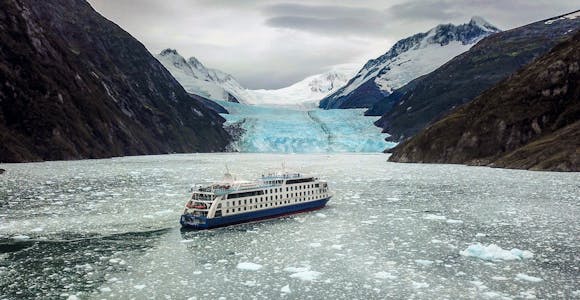
Patagonia Wildlife
Patagonia is home to an array of amazing wildlife. We work with hand-picked local wildlife guides to help you experience the region's nature at its finest.
Discover MoreDeep roots in Patagonia: We are ex-guides, tour leaders, outdoor enthusiasts, & adventurers.
We’ve got our feet on the ground: Impartial advice, a bespoke service, and at no extra cost.
For the ends of the Earth: Sustainability is more than our carbon footprint (but we’re reducing that too).

Both Patagonia’s Atlantic and Pacific coasts are teeming with wildlife, and the best way to put yourself in the action is by taking the water on an adventure cruise ship or a small boat expedition. From whales and penguins to sea lions and seabirds, choose between general or specific wildlife encounters to experience the best of Patagonia’s wild side.

Watching humpback whales in the Chilean Fjords
Patagonia is a brilliant place for whale watching. There are four main species you might encounter in its waters: the southern right whale, the orca, the humpback and, most thrilling of all, the blue whale – the world’s largest mammal.
Southern right whales congregate around Peninsula Valdes in Argentina between June and December, when they visit this globally important breeding ground to both mate and give birth. Day cruises offer the opportunity to observe these colossal yet peaceful creatures.
Orcas are also commonly seen around Peninsula Valdes, but they come to eat rather than breed. In October and November they dine out on elephant seal pups, then return in March through to May for the sea lion pups. For the latter, the orcas here intentionally beach themselves to pluck their prey from the surf: a behaviour seen nowhere else on the planet.
Humpback whales are best seen in the waters of Francisco Coloane Marine Park in the southern Chilean Fjords, and accessible only by boat. Humpbacks pass through on their migration between December and April.
For the chance of seeing blue whales, head to the Corcovado Gulf, a recently-created Marine Protected Area visited by adventure cruise ships. As with the humpbacks, December to April is the time when blue whales are here, feeding and nursing their calves.

Magellanic penguins in Tierra del Fuego
Patagonia is home to four species of penguin: Magellanic, Humboldt, rockhopper and king penguins. In a number of places you can visit them on day trips by land but the most rewarding experiences all come from the sea. October to March is the best time to see penguins, when they come ashore to breed and raise their chicks before returning to sea.
Magellanic penguins are Patagonia’s most iconic penguin species. The most interesting colonies to visit are also the remote: the Tucker Islets or Magdalena Island, both of which can be visited on a Cape Horn cruise around Tierra del Fuego. Magellanic penguins are a burrowing species, nesting in short tunnels they return to every year.
Magellanic penguin colonies can be found at spots all the way along the Chilean Fjords as well as Peninsula Valdes. At Puñihuil on Chiloé, accessible only by boat, they share a colony with Humboldt penguins, the only known place where the two species can be found together.
When cruising in in Tierra del Fuego, keep your eyes out for rockhopper penguins which nest on remote islands near Cape Horn. They’re well-named for the way they scale cliffs to their nesting sites, but may equally be seen swimming close to shore.
South America’s only king penguin colony can be found at Useless Bay in Tierra del Fuego, a day-trip by boat (rather than cruise ship) from Punta Arenas.

South American sea lions in the Chilean Fjords
While whales are a major attraction during wildlife trips in Patagonia, there are numerous other marine mammals to spot on board.
The South American sea lion, the most commonly seen seal species, resides in colonies along both Patagonia's Atlantic and Pacific coasts. You can find them scattered around the Chilean Fjords and Tierra Del Fuego, particularly on the islets of the Beagle Channel and in a sizable resident colony at Peninsula Valdes.
South American fur seals are often mistaken for their sea lion cousins, but are typically found in the northern Chilean Fjords. They have a shorter bear-like face, unlike the more dog-like face of sea lions.
The Southern elephant seal, Patagonia’s only true seal species, can be encountered in Peninsula Valdes or isolated colonies like Guardrimo Fjord in the southern Chilean Fjords or Ainsworth Bay in Tierra del Fuego. The massive males engage in battles for harem control just before the cruise season begins, but you can still see them on beaches, and from October/November, plenty of their pups.
Patagonia's waters also host various dolphin species. In Tierra del Fuego, keep an eye out for Commerson's or Peale dolphins, both displaying striking black and white colouring similar to a panda. Further north on both coasts, common dolphins, dusky dolphins can also be spotted, along with the Chilean dolphin, exclusive to Pacific waters.

Imperial cormorant off the coast of Tierra del Fuego
Don’t let Patagonia’s charismatic penguins steal the limelight on a wildlife cruise: there are plenty of other birds to be seen during your trip.
Two species you’ll quickly become familiar with are the imperial cormorant and the Magellanic cormorant (also known as the rock shag). These agile divers are often seen perched on rocky outcrops, drying their wings after a successful fishing session; imperial cormorants are a glossy dark blue and white, while Magellanic cormorants tend to black or oily green.
In Tierra del Fuego and the Corcovado Gulf you may be lucky to see the Southern Ocean’s most graceful bird: the albatross. Black-browed albatross may be seen off the coast, along with the more chunky southern giant petrel in Tierra del Fuego. Both fly with an almost effortless ease and it's a true joy when either follows your ship. Smaller sea birds include the sooty shearwater and Austral and Dominican gulls.
Not a seabird but something special to look for nonetheless is the Andean condor, the world’s largest flying bird. Always keep a close eye out for its distinct wing profile whenever your ship is hugging the mountainous coastline: it’s one of Patagonia’s most iconic species.
When hiking off the ship, always keep a watch for the Magellanic woodpecker. These can be found from the forests of Tierra del Fuego up to the tip of the northern Chilean Fjords. With its black plumage and bright red head, it’s instantly recognisable and a great addition to anyone’s bird list, so keep your eyes peeled and binoculars at the ready!
The Whale Watching was incredible, we saw over 40 whales in just 3 days!
Travelled: March 2016
Eddie -

Visiting a Magellanic penguin colony on the Tucker Islets
Patagonia’s wildlife cruising season runs from October through to the start of April, which is the period when wildlife is most active.
Different species are more active at different times of the season. For example, humpback and blue whales may be seen from December through until April, when they pass through on their migration. Magellanic penguins lay their eggs from October, with chicks starting to appear by early December and starting to fledge in March. Sea lion pups appear around the same time.
Exceptions to this calendar are the southern right whale, who come to Peninsula Valdes from June through to December, and are visited on day trip vessels from Puerto Madryn.
Longer cruises take place on small ships, carrying just under 100 passengers in the Chilean Fjords and up to 210 passengers in Tierra del Fuego. Expert wildlife guides on board will help you spot the animals and give educational talks (in English and Spanish) about their ecology, as well as the history and culture of the region. All ships have comfortable en suite cabins in a selection of classes. Daily excursions are made to remote locations by small boat or zodiac.
Humpback whale trips to Francisco Coloane Marine Park take a slightly different shape – sailing by small boat to a remote research station, where you stay in a camp and take cruises with local marine biologists who can identify almost every individual whale by name.
These trips are often described as ‘cruises for people who don’t do cruises’. Based on a small ship carrying up to 210 passengers, they're the perfect way to explore some really remote areas, with plenty of opportunity to get off the ship and explore, or do cruises in small zodiac boats. They're more akin to an Antarctic expedition cruise to something you might find in the Caribbean or Mediterranean.
Many landings include the option to do a short hike to a viewpoint over a glacier or similar. The hikes usually include routes rated from easy to moderate, though even those rated for the most active guests can typically be done by anyone with a reasonable level of fitness. All excursions and hikes are optional.
Patagonia’s weather can famously encompass four seasons in a single day – a motto that Tierra del Fuego embraces with a passion.
Throughout the cruising season, temperatures average somewhere between 5–15C (41-49F). Strong winds are always a possibility, along with rain and even the occasional snow flurry. Zodiac landings require water-proof gear as you’ll be exposed to the elements, so it's wise to pack accordingly.
The changeable weather at Cape Horn has been famous for centuries, so there is always a small chance that conditions may prevent a landing. However, in recent seasons, over 80% of visits to the Horn had successful landings there.
Wildlife sightings can never be guaranteed but the cruise ships call at either the Tucker Islets or Magdalena Island, which are both home to large Magellanic penguin colonies. At the Tucker Islets (visited on the Ushuaia-Punta Arenas route, visits are made by zodiac. At Magdelana Island (visited on the Punta Arenas-Ushuaia route), it's possible to land and see the penguins from the shore.
Magellanic penguins come ashore between early October and late March to breed, coinciding with the operating season for the ships. The months outside this are spent at sea.

Patagonia is home to an array of amazing wildlife. We work with hand-picked local wildlife guides to help you experience the region's nature at its finest.
Discover More
Join a dedicated whale-watching cruise or boat trip with specialist guides to protected fjords and bays in either Chile or Argentina to observe Patagonia's whale up close.
Discover More
Steeped in maritime history and myth, Cape Horn lies off Tierra del Fuego at South America's southernmost tip, accessible only to adventurous travellers by cruise ship.
Discover More
Get to parts of Patagonia that even the toughest hikers can't reach. Adventure cruises take you to the glaciers of the Chilean Fjords and Cape Horn off Tierra del Fuego.
Discover MoreWe'll spend some time listening to your aspirations, then discuss the kind of experience that might suit you.
Next we'll discuss the options, shortlist the best trips for you and present you our impartial recommendations.
We'll place a 24 hour hold on your preferred option - without obligation - whilst we talk through the details.
Whatever your budget, group size, length of stay, preferred activity or appetite for adventure, we can help.
1 888 970 4571This website uses cookies to ensure you get the best experience on our website. Privacy policy